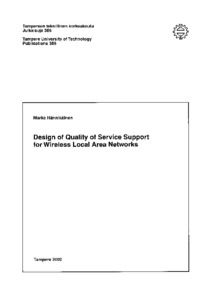Design of Quality of Service Support for Wireless Local Area Networks
Hännikäinen, M. (2002)
Hännikäinen, M.
Tampere University of Technology
2002
Tietotekniikan osasto - Department of Information Technology
This publication is copyrighted. You may download, display and print it for Your own personal use. Commercial use is prohibited.
Julkaisun pysyvä osoite on
https://urn.fi/URN:NBN:fi:tty-200810021112
https://urn.fi/URN:NBN:fi:tty-200810021112
Tiivistelmä
Wireless Local Area Networks (WLAN) operating on unlicensed radio frequency bands are emerging in a number of application areas. They both extend and replace traditional wired LANs. Wireless Personal Area Network (WPAN) is a type of WLAN that targets low cost of technology, small size, and low power consumption.
As the multitude of application types utilising data networks is increasing, new requirements are placed on both wired LAN and WLAN services. Many projected applications require time bounded data transfer. Consequently, Quality of Service (QoS) support is required in order to enable different applications to operate.
This thesis presents a design of Quality of Service (QoS) support for WLANs. The work concentrates on a WLAN called Tampere University of Technology Wireless Local Area Network (TUTWLAN). TUTWLAN is being developed for research purposes, not destined to meet current or emerging WLAN standards. This enables to more freely experience with different functional alternatives.
The QoS support requirements and justification for the TUTWLAN design are drawn from the interoperability requirements with higher layer protocols and peer wired LAN and WLAN technologies. The main entity for QoS support in TUTWLAN is the Medium Access Control (MAC) protocol called TUTMAC. Other central components are a TUTWLAN Access Point (AP) and a transport layer protocol for a wireless video demonstrator application. The work also contains a hardware demonstrator platform and several other software components and applications for the TUTWLAN implementation.
TUTWLAN has a centrally controlled topology, as data transfer services are enabled by changing control and management messages between a TUTWLAN base station and portable terminals. The channel access is based on dynamic reservation Time Division Multiple Access (TDMA). Interconnection to backbone wired LAN is implemented by the TUTWLAN AP module located in a TUTWLAN base station. AP adapts the QoS signalling between different connected LANs and supports QoS in data forwarding.
The TUTMAC protocol is implemented for the MAC processor of the platform using the Specification and Description Language (SDL). SDL has been found to be a suitable specification, simulation, and implementation tool for the TUTMAC protocol. In addition, programmable logic is needed for accelerating the most time critical TUTMAC functions.
As the multitude of application types utilising data networks is increasing, new requirements are placed on both wired LAN and WLAN services. Many projected applications require time bounded data transfer. Consequently, Quality of Service (QoS) support is required in order to enable different applications to operate.
This thesis presents a design of Quality of Service (QoS) support for WLANs. The work concentrates on a WLAN called Tampere University of Technology Wireless Local Area Network (TUTWLAN). TUTWLAN is being developed for research purposes, not destined to meet current or emerging WLAN standards. This enables to more freely experience with different functional alternatives.
The QoS support requirements and justification for the TUTWLAN design are drawn from the interoperability requirements with higher layer protocols and peer wired LAN and WLAN technologies. The main entity for QoS support in TUTWLAN is the Medium Access Control (MAC) protocol called TUTMAC. Other central components are a TUTWLAN Access Point (AP) and a transport layer protocol for a wireless video demonstrator application. The work also contains a hardware demonstrator platform and several other software components and applications for the TUTWLAN implementation.
TUTWLAN has a centrally controlled topology, as data transfer services are enabled by changing control and management messages between a TUTWLAN base station and portable terminals. The channel access is based on dynamic reservation Time Division Multiple Access (TDMA). Interconnection to backbone wired LAN is implemented by the TUTWLAN AP module located in a TUTWLAN base station. AP adapts the QoS signalling between different connected LANs and supports QoS in data forwarding.
The TUTMAC protocol is implemented for the MAC processor of the platform using the Specification and Description Language (SDL). SDL has been found to be a suitable specification, simulation, and implementation tool for the TUTMAC protocol. In addition, programmable logic is needed for accelerating the most time critical TUTMAC functions.
Kokoelmat
- Väitöskirjat [4773]
